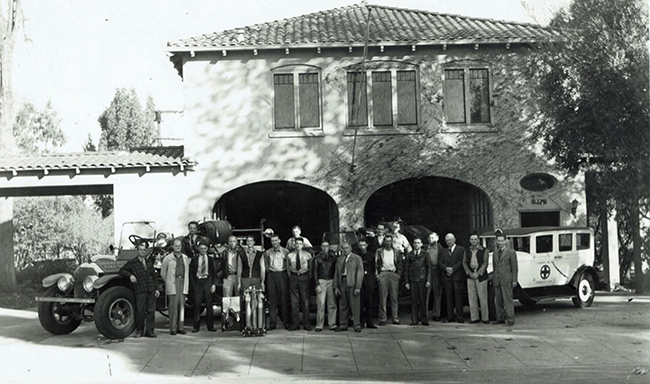Meals on Wheels provides vital service
Bashiri Thumbutu, who’s been delivering meals to people in need for around 15 years, gently knocks on the screen door to a home on a quiet Mills Avenue block.
“Hi there, Meals on Wheels,” he says brightly as he opens the door. “How are you today?”
Peter DiCesare is sitting on a couch in the living room. Mr. Thumbutu places the paper bag full of food—chicken, a salad, potatoes, peas and a carton of milk—on the dining room table. After exchanging pleasantries, it’s off to the next house.
Mr. DiCesare’s lunch is one of dozens on Mr. Thumbutu’s late-morning route, one of 10,000 meals the Claremont Meals on Wheels program will deliver this year to residents in need.
The local Meals on Wheels chapter started in 1972 and has been helping those in need ever since, according to Bob Rogers, who acts as treasurer. Mr. Roger’s wife, Ethel Rogers, is the organization’s president.
Mr. Rogers noted that about 50 meals are prepared and sent out every morning throughout the city. “That’s not homes, that’s people,” he emphasized.
On this particular Friday morning, 64 meals were prepared. They’re prepped daily in a basement room at Mount San Antonio Gardens, where the kitchen staff cooks them early in the morning and a diligent team of about a half-dozen volunteers packs them for the day.
The packing team, headed by Volunteer Coordinator Barbara Gonzalez, takes about two hours to prepare every meal, from filling sack lunches to encasing the hot food items in plastic to keep them fresh. The Friday rush is a little busier, she explains, because some clients want an extra meal for the weekend.
The volunteers pay careful attention to dietary restrictions—brown bags indicate a regular meal, while white bags indicate special requests made by the clients, such as nonfat milk, no dessert or no salad.
Some volunteers have been around for a while, and others are relative newcomers to the group. Nirmala Desamoni has been packing meals for the organization for the past five years, volunteering every other Friday morning. Rose Malone started volunteering a few months ago.
“I find it very fulfilling,” Ms. Malone said.
Mr. Rogers explained that the people who work with the program are doing it entirely out of the goodness of their hearts.
“There’s not a single person in the organization that draws a dollar of pay,” he said. “Everyone is a volunteer; every dollar goes to putting a meal out the door.”
This is crucial to the organization, which survives on contributions from the city—about $4,900 annually from Claremont’s Community Based Organization budget, according to Finance Director Adam Pirrie—as well as donations from the local Kiwanis Club and the public.
Claremont’s chapter of Meals on Wheels is separate from the national organization, meaning it’s safe from the Trump Administration’s sweeping budget cuts. Since the budget was unveiled, Ethel Rogers has been fielding concerns from residents about the future of the program.
“We’ve had people who have been very upset about reading in the paper of what’s going to happen with Meals on Wheels in particular,” she said. “We’ve been trying to reassure them that we get a city grant.”
But that doesn’t mean the group is financially sound. Mount San Antonio Gardens donates the basement space, but the cost of food and paper products places Meals on Wheels in the red, Ms. Gonzalez explained.
“Lately, we have had really good luck with asking all of our volunteers to ask [people] to support us,” Mr. Rogers said. “That’s been building in the last few years.”
The support from the volunteers does not go unnoticed—the Claremont Meals on Wheels’ 130 volunteers will be recognized on April 19 at the DoubleTree Hotel.
The benefits of the Meals on Wheels program reach far beyond delivering a hot meal to someone in need. Mr. Rogers noted the program is all about the human contact, as well as allowing elderly residents to continue to live independently in their homes.
“One of the studies shows there are fewer falls, because people aren’t using both hands to prepare meals,” he said.
The program also acts as a method of checking up on seniors who are living alone. Mr. Rogers, who lives with his wife at the Gardens, likens it to a daily ritual at the retirement community—they must press a button in their apartment every morning before 11 a.m. to let workers know they are safe.
Sometimes, if a client falls short of their monthly payments, Meals on Wheels helps them out to keep them in the program.
“In some cases we put them on a reduced price because of financial setbacks,” Mr. Rogers said. “We try to look out for them certainly in that point of view.”
Mr. Thumbutu has been volunteering for the organization for 15 years, starting a few years after he retired in 2000. Over the years he has spent as a driver and route organizer, he’s had countless interactions with clients, from talking about baseball to brief but friendly exchanges with clients who are suffering through diseases like dementia.
“This is an opportunity to give back to the community,” he said.
Mr. Thumbutu and his wife, Tengemana, rode together on his Friday morning route, which took them to various houses around south Claremont. The process is quick and methodical—Mr. Thumbutu knocks on the door, leaves the meal, exchanges hellos and goodbyes and moves on to the next house. The entire route is finished by noon.
As Mr. Thumbutu left Mr. DiCesare’s meal on the dining room table, the Meals on Wheels client flashed a big smile reflecting on how thankful he is for his regular visits.
“I couldn’t ask for a better organization,” Mr. DiCesare said.
—Matthew Bramlett
news@claremont-courier.com











0 Comments